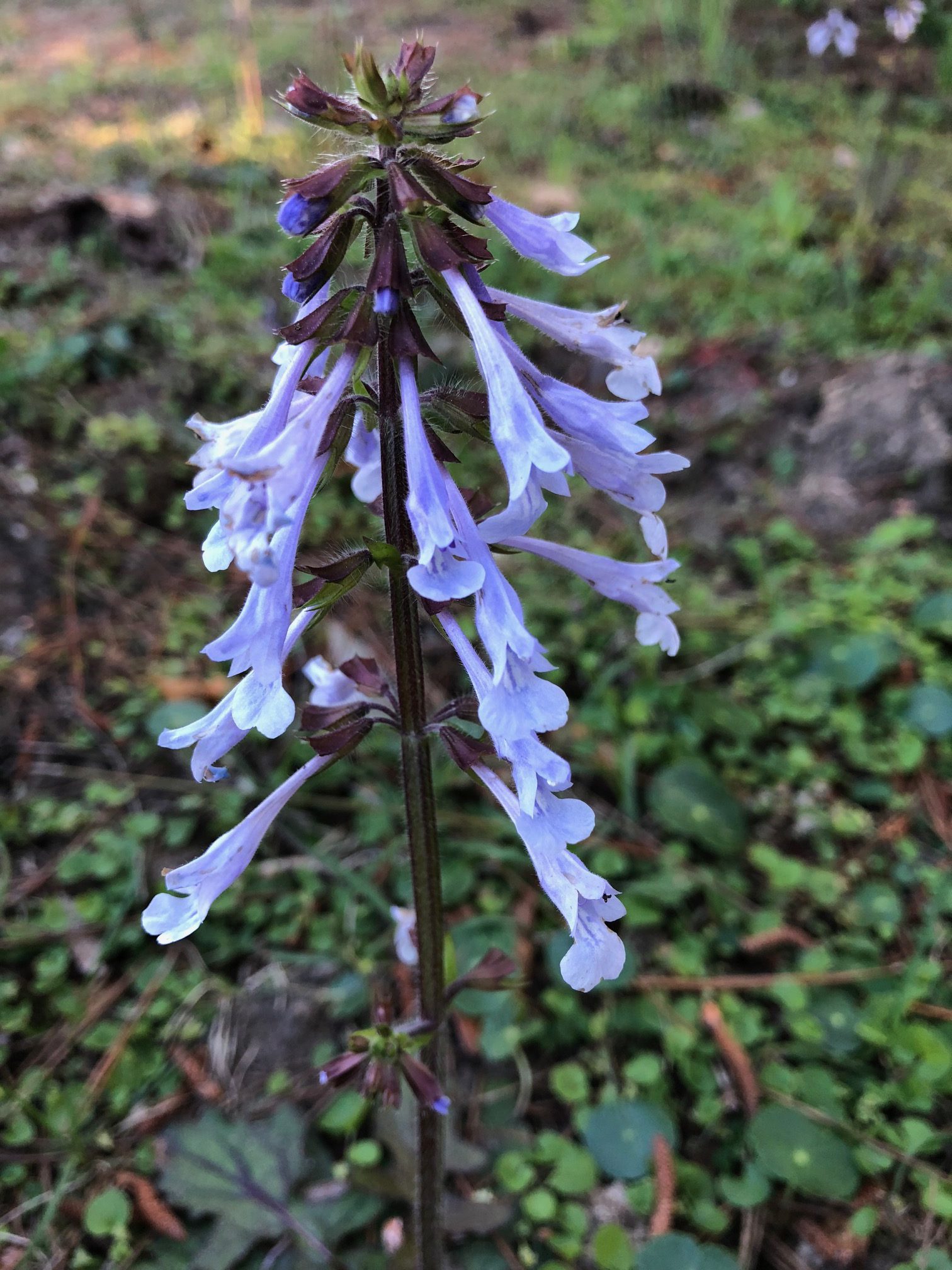
by Mary Salinas | Mar 26, 2018
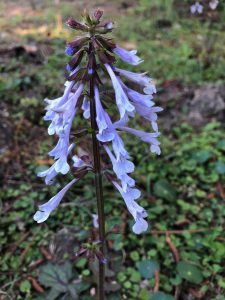
The spike of lavender blooms of lyreleaf sage. Photo credit: Mary Salinas.
Spring wildflowers are popping up along our roadways and along woodland edges. One of our native perennial beauties you can enjoy right now is lyreleaf sage, Salvia lyrata, with spikes of tubular lavender flowers rising about a foot above the ground. The blooms, which occur late winter through late spring, attract bees and butterflies and provide them a good source of nectar. It also is a good host plant for aphids, which in turn, can make it a good banker plant and feeding station for ladybug larvae.
The irregularly-shaped leaves grow in a rosette hugging the ground and can make for a natural ground cover in part shade areas. These attractive leaves are easily identifiable by their purple stems, edges and veins in sharp contrast to the bright green of the rest of the leaf. Lyreleaf sage belongs to the mint family and shares the characteristic square-shaped stems and two-lipped flowers.
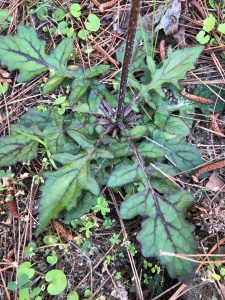
Leaves of lyreleaf sage form a ground hugging rosette. Photo credit: Mary Salinas.
Whatever garden conditions you have, lyreleaf sage should be able to adapt. It tolerates drought, flooding and most soil types. Be aware, though, that this beauty produces lots of seed and can spread quickly. This can be a very desirable trait for establishing a wildflower meadow but challenging if you want to keep it contained in a small area. To manage its’ spread, remove flower spikes after the blooms fade to prevent most seed formation.
Lyreleaf sage can usually be found in native plant or local nurseries; seed can be found through online wildflower seed sources.
For more information:
Planting and Care of Salvias in Landscapes
Florida Wildflower Foundation
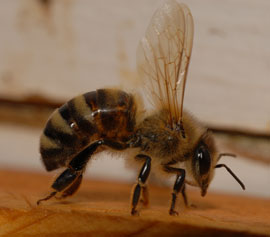
by Mary Salinas | Mar 21, 2018

European honey bee. Photo credit: UF/IFAS.
Bees, butterflies and other insects play important roles as pollinators in our environment. Over 50 major crops in the United States and at least 13 crops in Florida depend on honey bees. Many native plants in natural areas also depend on insect pollinators for reproduction. In Florida, over 300 bee species play a role in pollination!
Many factors affect the health of our pollinators. One of those factors we can easily control in our own landscapes is exposures to pesticides. How are bees and other pollinators exposed to pesticides? Here are some of the major routes:
- Drift of pesticides sprayed in breezy/windy conditions
- The erosion of contaminated topsoil blowing in the wind
- Direct feeding on pollen and nectar of treated plants
- Contact with pesticides that have blown onto plant surfaces
- Contact with water transpired by leaves of treated plants
- Pesticides that move down through the soil to affect ground dwelling bees and other insects
Did you know that bees become statically charged when they fly causing particles in the air to attract to them?
What are some ways that we can reduce the risk of exposure to pollinators in our landscapes?
- Use integrated pest management principles to reduce the incidence of pests and their impacts.
- Avoid treating areas containing flowering weeds/plants with insecticides. If you must treat your lawn with an insecticide, and it contains flowering weeds, mow the lawn and remove the flowers just before applying the insecticide.
- If you must apply a systemic insecticide to your lawn, leave a buffer strip of several feet between the lawn and the border of landscape beds with flowering plants. This will prevent the flowering plants from up taking the systemic product.
- Postpone any insecticide treatment until after all blooms have fallen from flowering ornamentals. Never apply an insecticide to blooms or flowering plants.
- Avoid the use of neonicotinoids as this class of insecticides can be more toxic to bees than other classes of insecticides. There are many effective alternatives.
Bee friendly to our pollinators!
For more information:
Minimizing Honey Bee Exposure to Pesticides
Creating and Maintaining Healthy Pollinator Habitat – Xerces Society
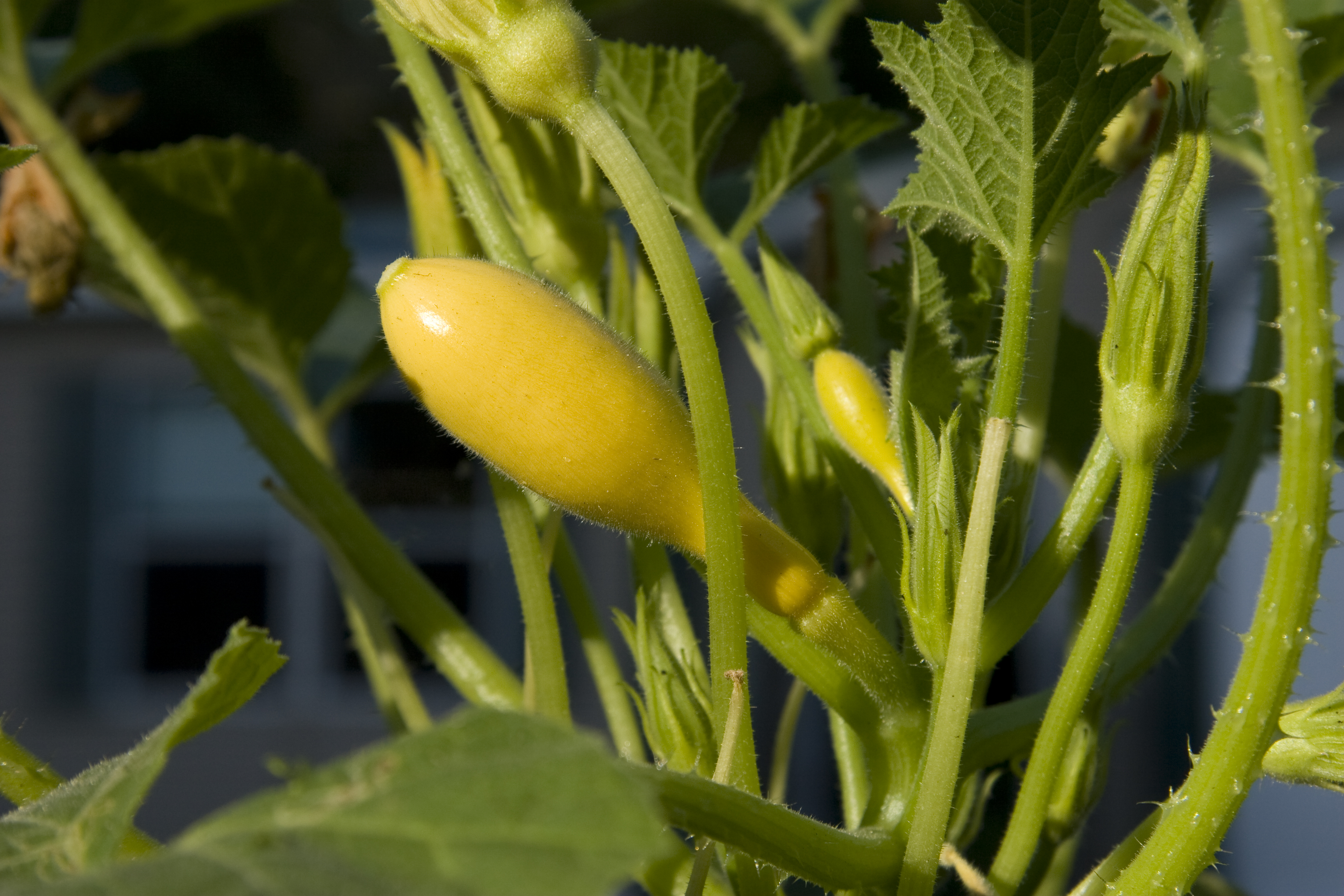
by Mary Salinas | Jan 25, 2018
Get a head start on your spring vegetable garden by planting seed now for some of your favorite spring crops. A great advantage to starting from seed is the seemingly endless number of varieties of your favorite vegetables that are available from online seed companies. You can experiment with new and heirloom varieties. Look to plant several different varieties that will mature at different times, thereby lengthening your harvest season.
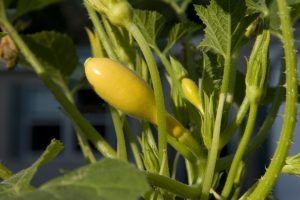
Home grown squash. UF/IFAS Photo by Tom Wright.
Seed is also cheaper than purchasing transplants, especially if you save your seeds in optimal conditions. To save leftover seed, keep it tightly closed in the original packet and store in a closed jar or plastic storage bag along with a desiccant (one of the little packs that come in vitamin bottles or shoe boxes) to absorb any excess moisture. Place in a consistently cool place, like your refrigerator. Some seeds naturally keep longer than others.
No fancy pots are needed, just about anything several inches wide and deep with a drainage hole will work. The pots should sit in a shallow waterproof tray to catch the runoff. Be sure to sterilize any reused pots with a solution of 1 part chlorine bleach to 9 parts water to destroy any lingering pathogens from the previous plants.
A commercial seed-starting mix is your best choice. Compressed peat or coir pots are also a good choice. Some all-purpose potting mixes are okay, but others are heavy and can hold too much water and promote fungal disease.
Plant the seed according the packet instructions, water well and place in a nice sunny spot where you can check them every day. If you don’t have a convenient sunny spot, a shop light with florescent and/or grow lights mounted about 6 inches above the tops of the plants will work well. A timer for the light is a handy device to make sure your seedlings have a good 14-16 hours of light a day. If your pots are in a sunny window, rotate them 180° daily to insure uniform growth. If you find your seedlings skinny and stretched, they are not getting enough sun.
Make sure that the soil stays evenly moist from the time of planting until the young plants are ready for your garden. A clear cover over the pots or tray will help to keep moisture consistent while the seeds germinate.
When the time comes to transition your plants to the outdoors, do it gradually. Expose them to the sun for an hour or two the first day and gradually increase their ‘sunbathing’ time each day for about a week and then transplant them to their new home.
Happy Gardening!
For more information:
Florida Vegetable Gardening Guide
Organic Vegetable Gardening in Florida
Seeding the Garden
Starting the Garden with Transplants
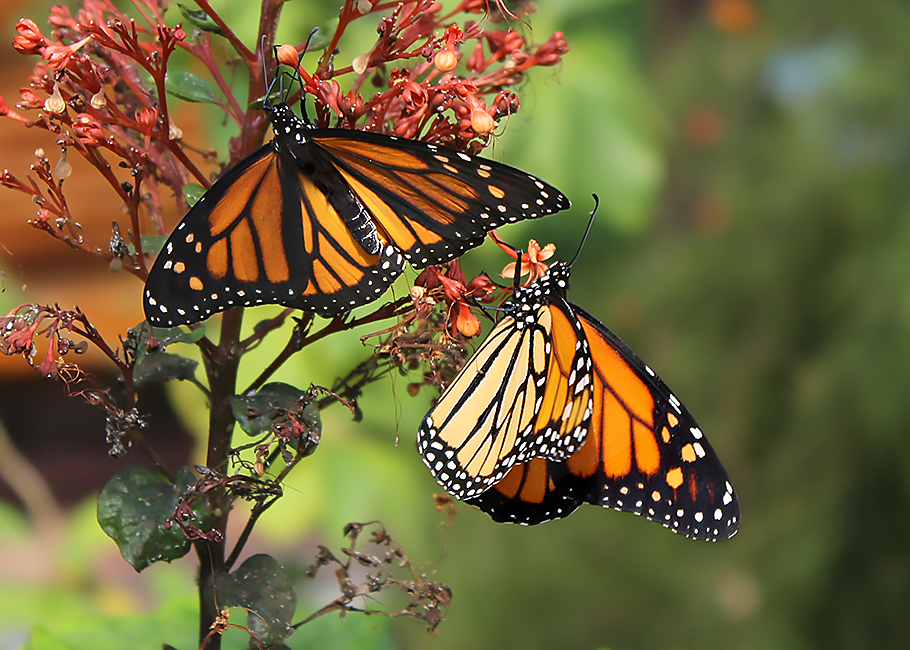
by Mary Salinas | Dec 14, 2017
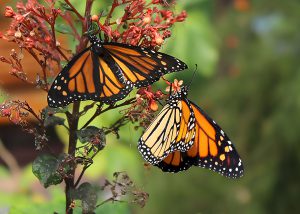
Monarch butterflies. Photo credit: Pia-Riitta Klein.
We have grown to love monarch butterflies, with their striking orange and black markings and their fascinating annual migration from southern Canada 3,000 miles south to Mexico. To help them, we have increasingly planted milkweed, the only plant on which their caterpillars will feed. In northwest Florida, the milkweed species most planted has been tropical milkweed, Asclepias curassavica, as it is lush, showy and easy to grow.
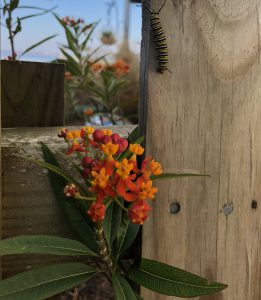
Tropical milkweed, Asclepias curassavica, was visited by this monarch caterpillar who is now off to find a suitable place to make his transformation into a chrysalis. Photo by Mary Salinas, UF/IFAS Extension.
Tropical milkweed, unlike our native milkweeds that die back in late fall, will continue to grow through the winter unless killed by a hard freeze. Even if the cold kills the stems, it may regrow quickly from the roots. This seems like an advantage, but maybe not. The availability of a host plant for the caterpillars may be prompting adult females to stay and lay eggs rather than migrate south and be protected from deadly freezes.
Experts are also exploring links between the longer persistence of the tropical milkweed into winter and a build-up on those plants of a serious parasite Ophryocystis elektroscirrha, commonly referred to as OE.
So, what is the answer?
- Cut back any tropical milkweed to the ground at Thanksgiving. That may encourage female monarchs to migrate and prevent a deadly build-up of OE spores on the plants.
- Consider adding some native milkweed species to your butterfly garden. Here are some recommended species from Dr. Jaret Daniels:
- Aquatic Milkweed (Asclepias perennis)
- Swamp Milkweed (Asclepias incarnata)
- Pinewoods Milkweed (Asclepias humistrata)
- Redring Milkweed (Asclepias variegata)
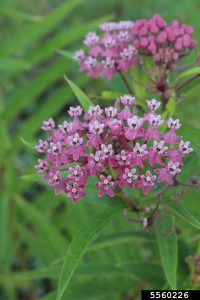
Swamp Milkweed, Asclepias incarnata. Photo credit: Chris Evans, University of Illinois.
For more information:
Are non-native milkweeds killing monarch butterflies?
Monarch Joint Venture: Potential risks of growing exotic (non-native) milkweeds for monarchs
Monarch Butterfly, Danaus plexippus Linnaeus (Lepidoptera: Nymphalidae: Danainae)
MonarchWatch.org
Gardening Solutions: Milkweed
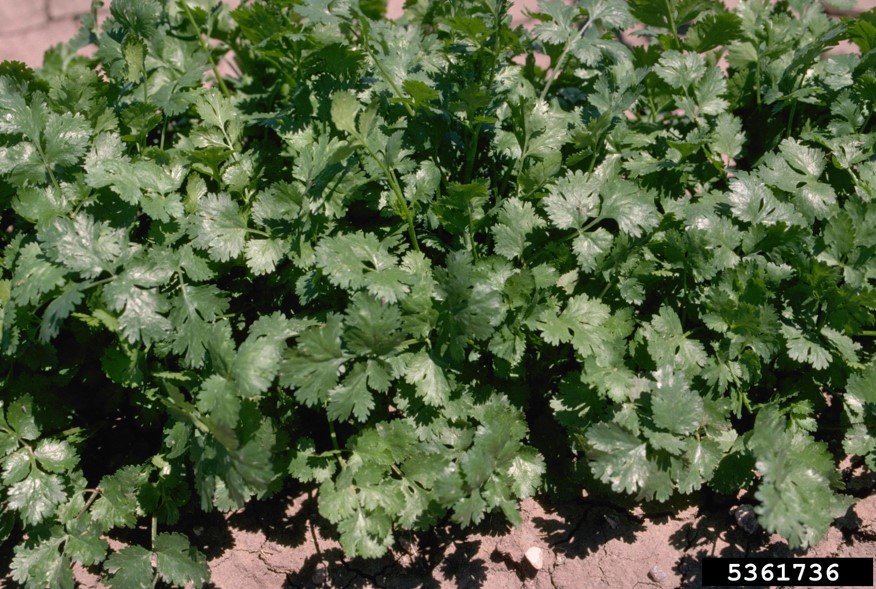
by Mary Salinas | Nov 13, 2017
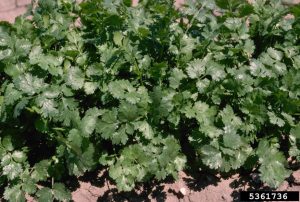
Cilantro ready for harvest. Photo credit: Howard F. Schwartz, Colorado State University, Bugwood.org
Cilantro (Coriandrum sativum) is a short-lived annual herb with bright green, feathery, flat leaves that look very similar to flat-leaved parsley. Leaves can be harvested at will after they grow to a mature size and then continuously as needed. The flavor of cilantro compliments many Latin American, Indian and Asian dishes and is a great addition to salads. The ripe seeds are known as coriander and used as a spice.
Maybe some of you have grown cilantro, harvested a time or two and then watched in horror as it quickly flowered, went to seed and died. Me, too. This scenario most likely happened in the warm summer months. Hot weather and long days stimulate this annual herb to quickly complete its life cycle. When temperatures increase, it causes plants to bolt which is a sudden switch to producing flowers and seeds, often on tall stalks. After cilantro bolts, the leaves become smaller and less palatable.
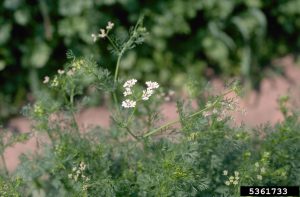
Cilantro bolting and blooming. Photo credit: Howard F. Schwartz, Colorado State University, Bugwood.org
The solution is to grow cilantro in the fall and winter. The cooler weather encourages more leafy growth, so you can harvest the leaves for a longer period of time. The warmer weather in the spring will bring flowers, and then seeds to start next autumn’s planting. Collect the seeds and store for planting the following season.
Start cilantro in your garden from seed or transplants. A benefit of growing from seed is that a few seeds can be sown every two weeks to extend your harvest season. Like most herbs, cilantro likes rich, well-drained soils, regular moisture and full or part sun. If the weather is getting warmer, full sun in the morning with some afternoon shade will help keep the herb cooler and less likely to bolt.
For more information:
Herbs in the Florida Garden
Seeding the Garden













